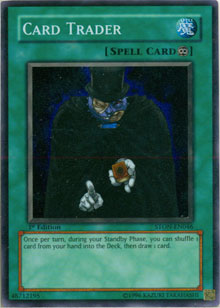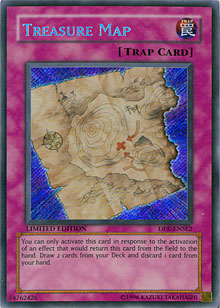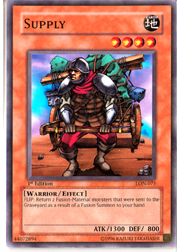Welcome back to my "getting back in the game" series! If you remember the first part of this series, I outlined a few basic methods to start rebuilding your collection. I think it’s important to be armed with the proper supplies and methods so you can be more effective in your efforts. Everyone wants a ton of cards, but reality will soon teach you that all those cards pile up quickly. Try purchasing just one booster box and you’ll see what I mean. Also, you’ve probably realized that winning prizes through competitive play alone is not consistent enough to build a decent collection. It’s a good starting point, but you need more leverage to accomplish your goal. Whether you’re new to the game or seeking to restore your collection to its former glory, this article will show you how to increase your card inflow.
Methods for Building a Stockpile
Last time, I wrote about the process I used to build my collection from scratch with very little money. It was more difficult a few years ago before many of the online services we have today existed. In this respect, you have a massive advantage compared to my situation. If you’ve been following my approach, there are ways you can enhance the number of new cards you earn per month. One answer is getting certified as an Upper Deck Judge. There are many benefits to becoming a certified rulings expert in the  game. You gain a technical perspective on the game, and when I say that, I mean that you come to understand the mechanics behind the game system. There isn’t a player out there who can tell you that he or she hasn’t received any kind of benefit from becoming a judge, competitively or otherwise. Another bonus when you choose to volunteer your time to better the game is the "free" product (usually booster packs) at the end of the day. I say "free" because you didn’t buy them with cash, but you traded your time in exchange instead.
game. You gain a technical perspective on the game, and when I say that, I mean that you come to understand the mechanics behind the game system. There isn’t a player out there who can tell you that he or she hasn’t received any kind of benefit from becoming a judge, competitively or otherwise. Another bonus when you choose to volunteer your time to better the game is the "free" product (usually booster packs) at the end of the day. I say "free" because you didn’t buy them with cash, but you traded your time in exchange instead.
When you go from being strictly a player to splitting your time between playing and judging, you immediately gain an advantage over those who decide only to play. Mainly, you have access to more packs per month than any player can amass by simply winning local tournaments or Regional Qualifiers full time. Keep in mind that you have to be very good at what you do. Judging one or two events isn’t enough. You’re trying to build a resume here. The more you judge and the better the job you do, the more events you get to preside over that pay out more packs per day. This isn’t easy. It’s probably just as hard getting good at the game competitively. For details, read my brief manifesto on the difficulties you’ll face as a judge. Trust me when I say that becoming a judge is very rewarding and that packs are only a small part of that. I get a sense of accomplishment at the end of a well-run event knowing that I had an influence on that outcome, and everybody involved benefits.
Another way to get more cards per event is to pick up the basic skills of trading. Trading is a great way to obtain truly rare cards you might not be able to get otherwise. I’m not the most skilled trader in the world, but there are a few things I do know. The first is that no one likes to be ripped off. The goal of trading is to engage in a mutually beneficial exchange. Obviously, hoodwinking the other person purposely is not going to get you very far in the long run.
Second, know the basic techniques. There are a number of tricks you can use to deal with numerous trading situations. Why should you know this? Because you want to get the best cards for the lowest overall cost and you want to be ready for other traders. A basic tactic is the "take-away." Set up a deal you know will actually work out slightly in your opponent’s favor. Then, before agreeing to the finalization, express your uncertainty. Maybe someone else you talked to offered you a better deal and you said that you would think about it. You could point out that the trade isn’t quite even and elaborate on that with a number of reasons. The goal here is to get your trade partner to want to close the deal quickly just to get out of the high pressure situation. The result? Your exchange still works out well for the opposite party because that person gets what he or she wants and you walk away with a little extra.
Third, the condition of your cards is everything. A good deal can be sniped by the smallest crease. If you’re going to do any kind of trading successfully, I highly recommend using albums and binders along with card sleeves. Personally, I can’t take any traders’ cards seriously if they aren’t kept in good condition. I know many others who share this viewpoint. Trading for non-mint cards usually just isn’t worth it due to the standards of other traders.
Measuring Your Progress
It should go without saying that in order to register any real progress with your collection you’ll have to measure what you get. If you’re serious about building a large collection, then tracking your progress by packs is the best method. A good beginning goal is to obtain at  least 25 percent more packs than the previous month. If you earned 20 packs in the last month, then you want to earn at least five more in the next one. That’s a realistic goal in my opinion. If it costs you five dollars per tournament and you entered four tournaments last month, then it cost you 20 dollars in entry fees to earn 20 packs (about 80 dollars-plus worth of boosters). That’s a 300 percent return on your investment! Remember though: that’s a strict retail value and what you pull from the packs could be far more valuable.
least 25 percent more packs than the previous month. If you earned 20 packs in the last month, then you want to earn at least five more in the next one. That’s a realistic goal in my opinion. If it costs you five dollars per tournament and you entered four tournaments last month, then it cost you 20 dollars in entry fees to earn 20 packs (about 80 dollars-plus worth of boosters). That’s a 300 percent return on your investment! Remember though: that’s a strict retail value and what you pull from the packs could be far more valuable.
When you start judging tournaments, you can easily earn 24 packs for a day’s worth of work at a Regional Qualifier. The Duelist Genesis has some great ultra rares, and pulling a foil will no longer replace your regular rare either, so your box can "pay for itself" with a few cards. When you have enough experience to start head judging tournaments, then you can get more packs for your work. Even better, right? If you’re not ready for the responsibilities of a head judge, then I encourage you to preside over the two-day Sneak Preview events. You get the best opportunity to grab the newest product before itsretail release! Previews are valuable opportunities to get an edge in the trading arena. Typically, the new cards are much more sought after than cards from previous sets, due to the short supply. Take advantage of that opportunity.
Storage Tips
Of course, this article wouldn’t be much without a few tips for maintaining your collection. If you’ve already started building your hoard since my last article, you’ve probably noticed that nine cards per pack can fill up your room pretty quickly. The  question arises: "Where the heck do I put all this stuff?" Fortunately, there are companies that make products exclusively for trading-card gamers like you. Since your collection will grow faster than you think, you’ll need convenient storage, protection, and transportation. For storage, I personally recommend using the white cardboard boxes that local card shops sell. You know what I’m talking about, right? The boxes that your shop sells for two or three dollars each that you fold together? Yes, those. They’re invaluable for your storage needs. They’re short enough to fit under the lowest bed and they fit your closet like a glove. Instead of keeping your cards in giant stacks on your night table or computer desk, try using some sturdy boxes instead. Most hobby and gaming shops have them and if they don’t, just ask.
question arises: "Where the heck do I put all this stuff?" Fortunately, there are companies that make products exclusively for trading-card gamers like you. Since your collection will grow faster than you think, you’ll need convenient storage, protection, and transportation. For storage, I personally recommend using the white cardboard boxes that local card shops sell. You know what I’m talking about, right? The boxes that your shop sells for two or three dollars each that you fold together? Yes, those. They’re invaluable for your storage needs. They’re short enough to fit under the lowest bed and they fit your closet like a glove. Instead of keeping your cards in giant stacks on your night table or computer desk, try using some sturdy boxes instead. Most hobby and gaming shops have them and if they don’t, just ask.
Final Thoughts
By now, you should have the basic knowledge necessary to embark on your journey toward a respectable collection. Where you go from here is entirely up to you. Whatever your primary goal is, I’m confident that now you have what it takes to get the cards you want.
Until next time, remember to stay focused and have fun!
—Bryan Camareno